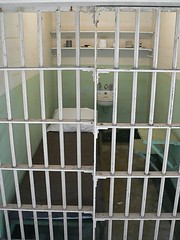 The National Juvenile Justice Network (NJJN) is an organization that helps state-based groups in their efforts to institute reform of the American juvenile justice system.
The National Juvenile Justice Network (NJJN) is an organization that helps state-based groups in their efforts to institute reform of the American juvenile justice system.
The NJJN describe themselves on their website as follows:
Through education, community-building and leadership development, NJJN enhances the capacity of juvenile justice coalitions and organizations in 33 states to press for state and federal laws, policies and practices that are fair, equitable and developmentally appropriate for all children, youth and families involved in, or at risk of becoming involved in, the justice system.
We seek to return the U.S. to the core ideals that led to the formation of the juvenile court more than 100 years ago, when our country realized that youth are fundamentally and categorically different than adults.
By providing tools to state level groups the NJJN seeks to achieve these ends. Access to information, leadership training, community building and other similar techniques are at the core of their approach. The most vital thing to know about them is their nine principles of reform. Every member adheres to these and must be actively working at the state level based on at least one of them. (These principles are from “A Blueprint for Juvenile Justice Reform,” developed by the Youth Transition Funders Group, associated descriptive text is my own paraphrasing and commentary on the original document.)
The Nine Principles are:
Reduce Institutionalization
While there will always be a few youth offenders that can only be dealt with through incarceration the vast majority of them can be more effectively treated in a community based environment.
Maximize Youth, Family and Community Participation
Community justice initiatives can engage a wide array of adults in the rehabilitation process, an important thing since active adult participation is often needed to keep youths involved in their own reform. Family conferencing is one example of how parents and jurisdictions are learning to work together rather than against each other.
Additionally they help both adults and youth become more active an effective in their efforts to lobby for reform.
Improve Aftercare and Reentry
With over 100,000 youths re-entering society after being institutionalized the question of how to re-integrate them into day to day life is of paramount importance. Youth programs and workforce development are key components here. For best effect many agencies, both government and non-profits, need to coordinate. Special needs kids – those with substance abuse or mental health issue in particular, need quick access to treatment if they are to have a fighting chance. Additionally there are questions of accessibility that need to be examined- if you cannot access the help it is not really helping.
Create Smaller Rehabilitative Institutions
Since the vast majority of youth are not chronic and violent offenders our system is ill suited for their needs. Those that are certainly need close supervision, but the impersonal and institutional atmosphere of jails, prisons, and detention centers have a poor track record. Especially when it comes to recidivism.
Smaller secure facilities run by youth specialists can provide developmentally appropriate programs for these youngsters. They can also be particularly effective if the family is closely engaged in the rehabilitative process.
Recognize and Serve Youth with Special Needs
It happens all the time. Youth whose primary problem stems from mental disorders, substance abuse, or emotional issues end up incarcerated with criminal offenders. They state it succinctly on their website:
While good mental heath and substance abuse services are vital for incarcerated youth to facilitate their rehabilitation, it is critical that juvenile justice involvement is seen as appropriate only when a youth’s delinquency—not his disabilities—is the primary reason for confinement.
Create a Range of Community Based Programs
While NJJN endorses and supports a variety of community based programs there are some that are particularly stressed due to their proven effectiveness. The three most highly noted, and with solid scientific evidence as their efficacy, are:
- Functional Family Therapy
- Multidimensional Treatment Foster Care
- Multi-Systemic Therapy (MST)
MST in particular has shown amazing results. Serious juvenile offenders demonstrate reductions of 25 to 70 percent in long-term rates of re-arrest, and reductions of 47 to 64 percent in out-of-home placements. Real results with no incarceration.
Ensure Access to Quality Counsel
In an age where counsel is sometimes assigned mere minute before trial it is imperative that something be done about it. NJJN supports beneficial reform in a variety of ways ranging from special training for those representing youth cases to early assignment of counsel. Any American appearing in court has the right to counsel, but lack of effective counsel is almost as bad, and sometimes worse than, having none at all.
Reduce Racial Disparity
As I noted yesterday in my examination of restorative justice, there is a huge racial disparity in the way our system treats youth offenders. The numbers bear repeating:
In 2008 Pew Charitable Trusts reported that one out of every 15 black men over the age of 18 is serving time. For comparison only one out of 106 white men are incarcerated. One in every nine African American men between 20 and 34 are incarcerated, a striking contrast to the 1 in 30 of that age group across the rest of the general population.
NJJN helps to support jurisdictions that have reduced this disparity and endorse the following proven tactics for doing so.
- analyzing data by race and ethnicity to detect disparities.
- using objective screening instruments to eliminate subjectivity from decision-making.
- coordinating with police to better control who enters the juvenile justice system.
- changing hiring practices so that justice staff are more representative of youth in the system.
- holding staff accountable for placement decisions.
- developing culturally competent programming.
- employing mechanisms to divert youth of color from secure confinement.
Keep Youth Out of Adult Prisons
Youth held in adult facilities are eight times as likely to attempt suicide as when incarcerated with their peers. They are five times more likely to report being rape victims; fifty percent more likely to be attacked with some sort of weapon; and twice as likely to be beaten by institution staff. These are not good numbers. Add in the much higher rate of recidivism and the over representation of people of color and the picture is bleak indeed.
Back in the 1990’s we saw 49 of the 50 states adopt measures that increased the number of juveniles being tried and sentenced as adults. Twenty years later we can see how much it has cost us as a society.
These are great principles, and ones which can lead the way to much improvement. Our juvenile justice system has some critical flaws and the active coordination of efforts to improve the situation is laudable.
Keep your eyes peeled as we will have an interview with some of the NJJN’s senior staff coming soon!
Image Source: timpearcelosgatos on Flickr, used under it’s Creative Commons license





 It is no secret that there is a link between education and one’s eventual path in life. Nowhere is this more painfully asserted than by the number of dropouts that end up in jail or prison. In Alabama, the officials have taken notice, and are using a short documentary film to communicate the “stay in school and out of prison” message to the students. Rick Harmon, a reporter for
It is no secret that there is a link between education and one’s eventual path in life. Nowhere is this more painfully asserted than by the number of dropouts that end up in jail or prison. In Alabama, the officials have taken notice, and are using a short documentary film to communicate the “stay in school and out of prison” message to the students. Rick Harmon, a reporter for  HUMAN
HUMAN Most people just walk right by the homeless. People living on the street are often viewed as the detritus of society, failed lives with no potential for betterment. Not to say that everyone feels this way, but there is a large segment of the population that does.
Most people just walk right by the homeless. People living on the street are often viewed as the detritus of society, failed lives with no potential for betterment. Not to say that everyone feels this way, but there is a large segment of the population that does.
 So many of our societal ills can be traced back to failures in the American educational system. Thus it is vitally important that we take an interest in that system and how it’s functioning.
So many of our societal ills can be traced back to failures in the American educational system. Thus it is vitally important that we take an interest in that system and how it’s functioning.







